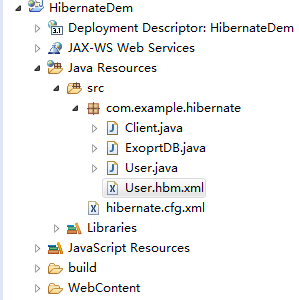hibernate
Hibernate体系结构
Hibernate架构包括许多对象持久对象,会话工厂,事务工厂,连接工厂,会话,事务等。
hibernate架构中有4层Java应用层,hibernate框架层,反手api层和数据库层。
Hibernate体系结构的要素
要创建第一个hibernate应用程序,我们必须知道Hibernate架构的元素。 它们如下:
会话工厂(SessionFactory)
SessionFactory是ConnectionProvider的会话和客户端工厂。 它拥有数据的二级缓存(可选)。org.hibernate.SessionFactory接口提供了工厂方法来获取Session的对象。
会话(Session)
Session对象提供应用程序和存储在数据库中的数据之间的接口。 它是一个短生命周期的对象并包装JDBC连接。 它是事务,查询和标准的工厂。 它拥有一级缓存(强制性)数据。 org.hibernate.Session接口提供插入,更新和删除对象的方法。 它还提供了事务,查询和标准的工厂方法。
事务(Transaction)
事务对象指定工作的原子单位,它是一个可选项。 org.hibernate.Transaction接口提供事务管理的方法。
连接提供者(ConnectionProvider)
它是一个JDBC连接工厂。 它从DriverManager或DataSource抽象出来的应用程序。 它是一个可选项。
事务工厂(TransactionFactory)
它是一个事务工厂,是一个可选项。
Hibernate快速入门:
1.项目结构如下:
1.
2.在对应的lib下引入相应的hibernate的jar包和依赖包,这里使用的是hibernate3,所需jar如图:

3.创建持久化类User类
package com.example.hibernate;
import java.util.Date;
public class User {
private String id;
private String username;
private String password;
private Date createTime;
private Date expireTime;
public String getId() {
return id;
}
public void setId(String id) {
this.id = id;
}
public String getUsername() {
return username;
}
public void setUsername(String userName) {
this.username = userName;
}
public String getPassword() {
return password;
}
public void setPassword(String password) {
this.password = password;
}
public Date getCreateTime() {
return createTime;
}
public void setCreateTime(Date createTime) {
this.createTime = createTime;
}
public Date getExpireTime() {
return expireTime;
}
public void setExpireTime(Date expireTime) {
this.expireTime = expireTime;
}
}
4.创建持久化类的映射文件User.hbm.xml
<?xml version="1.0"?> <!DOCTYPE hibernate-mapping PUBLIC "-//Hibernate/Hibernate Mapping DTD 3.0//EN" "http://hibernate.sourceforge.net/hibernate-mapping-3.0.dtd"> <hibernate-mapping> <class name="com.example.hibernate.User"> <id name="id"> <generator class="uuid"/> </id> <property name="username"/> <property name="password"/> <property name="createTime"/> <property name="expireTime"/> </class> </hibernate-mapping>
5.创建对应的数据库驱动hibernate.cfg.xml
<!DOCTYPE hibernate-configuration PUBLIC "-//Hibernate/Hibernate Configuration DTD 3.0//EN" "http://hibernate.sourceforge.net/hibernate-configuration-3.0.dtd"> <hibernate-configuration> <session-factory > <!-- mysql数据库驱动 --> <property name="hibernate.connection.driver_class">com.mysql.jdbc.Driver</property> <!-- mysql数据库名称 --> <property name="hibernate.connection.url">jdbc:mysql://localhost:3306/mybatis?useSSL=false&useUnicode=true&characterEncoding=utf-8</property> <!-- 数据库的登陆用户名 --> <property name="hibernate.connection.username">root</property> <!-- 数据库的登陆密码 --> <property name="hibernate.connection.password">123456</property> <!-- 方言:为每一种数据库提供适配器,方便转换 --> <property name="hibernate.dialect">org.hibernate.dialect.MySQLDialect</property> <mapping resource="com/example/hibernate/User.hbm.xml"/> </session-factory> </hibernate-configuration>
注意:在使用mysql数据库时,由于设置了安全模式所以需要加上useSSL=false,解除安全模式,这样才能完成数据库的修改
如果需要将数据库连接更换为c3p0,dbcp等可以参照:http://blog.csdn.net/qiaqia609/article/details/9456489/
6.创建持久化类对应的数据库表ExoprtDB
package com.example.hibernate; import org.hibernate.cfg.Configuration; import org.hibernate.tool.hbm2ddl.SchemaExport; /** * 将hbm生成ddl * @author BCH * */ public class ExoprtDB { public static void main(String[] args) { //默认读取hibernate.cfg.xml文件 Configuration cfr = new Configuration().configure(); SchemaExport export = new SchemaExport(cfr); export.create(true, true); } }
7.创建:Client 通过对象将对象的数据储存到数据库中
package com.example.hibernate; import java.util.Date; import org.hibernate.Session; import org.hibernate.SessionFactory; import org.hibernate.cfg.Configuration; public class Client { public static void main(String[] args) { //读取配置文件 Configuration cfg = new Configuration().configure(); SessionFactory factory = cfg.buildSessionFactory(); Session session = null; try{ session = factory.openSession(); //开启事务 session.beginTransaction(); User user = new User(); user.setUsername("用户名"); user.setPassword("123"); user.setCreateTime(new Date()); user.setExpireTime(new Date()); session.save(user); //提交事务 session.getTransaction().commit(); }catch(Exception e){ e.printStackTrace(); //回滚事务 session.getTransaction().rollback(); }finally{ if(session != null){ if(session.isOpen()){ //关闭session session.close(); } } } } }
总结:在操作整个hibernate的过程中,基本没有操作JDBC,对于数据的存储都是直接操作对象实现的
映射关系:实体类对应数据库表的表,实体类的属性对应数据库表的字段
补充:
1.创建持久化类的一些原则;
(1):实现默认的无参构造方法
(2):提供一个标识
(3):为每个属性提供一个getter和setter方法
(4):最好不要用final来修饰类,因为使用了fianl关键字,那么延迟加载(load)将会无效
2.Hibernate的一些主键生成策略
User.hbm.xml配置文件中有一个标签:<generator>。它表示的是主键生成策略。主键生成策略必须配置,用来为该持久化类的实例生成唯一的标识。



